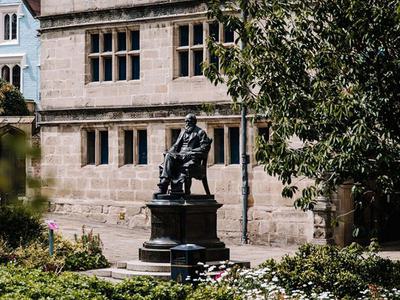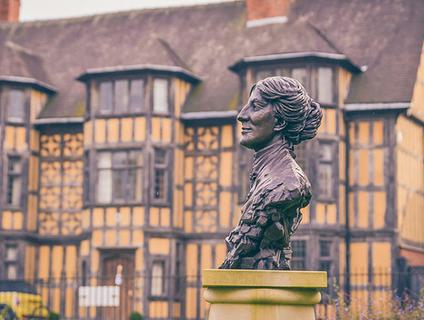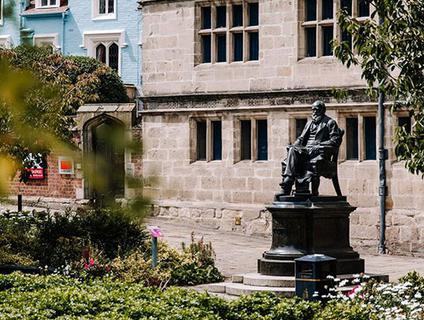- Features
- Monuments and statues in Shrewsbury
Monuments and statues in Shrewsbury


Mary Webb
A bust of critically-acclaimed Shropshire writer, Mary Webb, can be seen in the gardens beside Shrewsbury Library. Mary Webb was born in Shrewsbury in 1881 and wrote poetry and novels inspired by the villages, towns and nature of Shropshire.
The Mary Webb Society commissioned the bust to mark the centenary of Mary Webb’s first novel, The Golden Arrow, which was written in Pontesbury. It was created by local sculptor Jemma Pearson, cast in bronze at the Castle Fine Arts Foundry in Llanrhaeadr and unveiled in July 2016.
Hercules
The statue of the heroic Hercules stands proudly on the riverbank in the Quarry. He once stood in the grounds of Condover Hall and was a little worse for wear before restoration - his foot was crushed, his left arm badly decaying and his wrought iron internal skeleton had rusted away.
Hercules once stood opposite St Chad's Church and it's thought that the statue had been completely naked at that time. According to local legend, Hercules' nudity was an embarrassment to the church-going ladies of Shrewsbury, and so the fig leaf was added to the statue. But the restoration work, paid for by the Heritage Lottery Fund, discovered that poor Hercules never had the necessary equipment, and had always been covered up. The sensitive repairs were carried out at a London conservation studio.
Lord Hil
Lord Hill's Column towers on the outskirts of the town centre and is one of Shrewsbury's most notable landmarks. It is the tallest Doric column in England (a Doric column is thicker and heavier than an Ionic or Corinthian column) and stands at an impressive 133 ft 6 in (40.7 m) tall. It commemorates Rowland Hill, 1st Viscount Hill with a 17 ft (5.2 m) tall statue standing on the top. The column has been listed by English Heritage as a Grade II* structure.

Charles Darwin
Shrewsbury was Charles Darwin's place of birth, home, inspiration and influence, which is why a statue of the famous naturalist sits proudly outside the town's library.
Darwin was born at Mount House in Shrewsbury in 1809 and is certainly the town's most famous son. He claimed he was born a naturalist and that his liberal childhood in Shropshire helped to create the perfect inquisitive mind.
To follow in the famous footsteps of the explorer you can pick up the Darwin Town Trail which takes you to the important places around the town that influenced the young naturalist.
Clive of India
Erected in 1860, a bronze statue of Clive of India stands in Shrewsbury’s town square. Born in nearby Market Drayton, Major General Robert Clive was MP for Shrewsbury from 1761 until his death in 1774, he was also elected Mayor of Shrewsbury 1762-63.
Clive started his career as a British military officer and East India Company official, he was one of the key early figures setting in motion what would later become British India. Some of his actions resulted in the plundering of Indian treasures, and policies introduced on behalf of the EIC led to famines which proved disastrous to the local Indian farming population.
Laura's Tower
For impressive, panoramic views, head to Laura's Tower at the Castle.. Built by Thomas Telford, the 19th century tower is the perfect place to see the river Severn winding around the town, the column climbing high and the commanding Abbey.
The tower was built as a summerhouse around 1790 for Laura, the daughter of Sir William Pulteney. Its octagonal design, red sandstone walls and conical copper roof certainly make it stand out in Shrewsbury's skyline.
Quantum Leap
Sat on the banks of the river Severn you'll find the Quantum Leap. The abstract sculpture celebrates the bicentenary of the birth of Charles Darwin, who was born in the town in 1809, and is known locally as 'The Slinky'.
The sculpture is 12 metres (40 ft) high, 17.5 metres (57 feet) long, and weighs more than 113 tonnes, excluding foundations and piles. The work is abstract, and due to its Darwinian theme is commonly interpreted as representing dinosaur bones, DNA or a backbone.
Quantum Leap is the main point of a 'Geo-Garden', which celebrates Shropshire's geological diversity (the county containing 10 of the 12 geological periods).
